South Australia Travel Guide
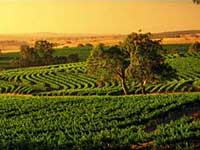
South Australia is bounded by other states on the west, east and north, and flanked in the south by the Southern Ocean. Most of its population of 1.5 million live in the fertile coastal area and the valley of the Murray River, which is the state's only navigable river and drains about one-seventh of Australia. The northern landscape consists largely of dry wasteland, with several low mountain ranges. The most impressive mountains are the Mt Lofty-Flinders ranges, extending about 500 miles (800km) from Cape Jervis to the northern end of Lake Torrens. The capital of South Australia is Adelaide, known as the City of Churches.
South Australia is famous mainly for its wine and opals. More than half of Australia's wine is produced here, the vineyards flourishing in its Mediterranean climate, and the State's three major opal fields, Coober Pedy, Mintabie and Andamooka, supply around 80 percent of the total world production of these sought-after gemstones.
Adelaide Travel Guide
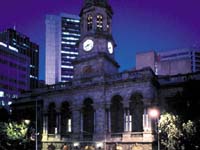 Why? The pleasant South Australian capital city has a laid-back feel, making a holiday in Adelaide a relaxing and enjoyable experience. Those who travel to Adelaide are surprised to find a multitude of sophisticated museums, galleries and festivals, not to mention a healthy gastronomic culture. A holiday in Adelaide also allows visitors to explore Aboriginal natural history and traditions with several cultural attractions.
Why? The pleasant South Australian capital city has a laid-back feel, making a holiday in Adelaide a relaxing and enjoyable experience. Those who travel to Adelaide are surprised to find a multitude of sophisticated museums, galleries and festivals, not to mention a healthy gastronomic culture. A holiday in Adelaide also allows visitors to explore Aboriginal natural history and traditions with several cultural attractions.When? Adelaide is delightful at any time of year. The city has a Mediterranean climate with hot summers and mild winters. Rain is possible between May and August.
Who for? An Adelaide holiday is for anyone looking for a relaxing get-away, spiced with some art and culture along with good food. Travel to Adelaide for a therapeutic break where you can stroll through the colonial centre, chug down the Torrens River, or explore acres of parkland.
More Info: Print out our Adelaide travel guide using the 'Print this Guide' tool for full information on the city. The Basics section includes useful information for international travellers from currency exchange to how much to tip, and how to phone home. The travel guide also reviews upcoming events, attractions and restaurants.
In keeping with its climate, Adelaide, capital of South Australia, has a Mediterranean ambience as it straddles the Torrens River, filled with churches, gardens, civic buildings, sidewalk cafes and a plethora of museums, galleries and festivals catering to the culturally inclined. The city was originally laid out in 1836 by Colonel Light in a square mile (three sq km) grid of wide streets with gracious colonial architecture. This has resulted in a compact inner city area, geared for easy exploring on foot, allowing the central area to be surrounded with hectares of parklands, walking trails, sports grounds and picnic areas on the banks of the river. The main boulevard is North Terrace, along which are the restored Mortlock Library, the Art Gallery of South Australia and the South Australian Museum with its spectacular whale skeleton and collection of Aboriginal natural history. Aboriginal culture is also catered for at Tandanya, a multi-arts cultural centre that has galleries, performance areas and a café serving native cuisine.
Visitors who have had enough of culture can take a cruise or gondola ride on the Torrens River, or ride a vintage tram to the nearby seaside town of Glenelg with its magnificent white, sandy beach, popular despite the occasional rumour of sharks. Adelaide's Central Market is the destination for 'foodies'. Among the noisy, colourful atmosphere and wondrous smells are fruit and vegetable stores and a large selection of meat and fish along with gourmet specialities introduced by the waves of immigrants who call Adelaide their home. Also popular with visitors is the Adelaide Zoo and Cleland Wildlife Park, which features local birds and animals including koalas and kangaroos.
===========================================================================
Tasmania Travel Guide
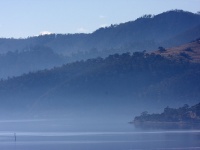
Cool morning near Derwent © kiwi vic
=====================================
Victoria Travel Guide
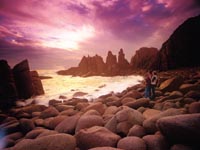
Pinnacles, Phillip Island © Victoria Tourism
Melbourne
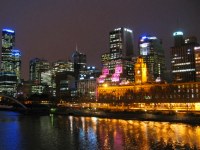 Why? It is often marketed as Australia's sophisticated 'culture capital', but in fact a holiday in Melbourne will reveal there is plenty more to do and see other than art galleries and theatre. Travel to Melbourne for a leisurely break, enjoying the many parks and recreational facilities, stroll along the St Kilda Esplanade, explore the river-front Southgate development, or watch an exciting Aussie Rules Football match.
Why? It is often marketed as Australia's sophisticated 'culture capital', but in fact a holiday in Melbourne will reveal there is plenty more to do and see other than art galleries and theatre. Travel to Melbourne for a leisurely break, enjoying the many parks and recreational facilities, stroll along the St Kilda Esplanade, explore the river-front Southgate development, or watch an exciting Aussie Rules Football match.
When? Peak seasons for holidays in Melbourne are dictated more by events than the weather, so it is wise to check what's on and book accommodation early to avoid disappointment. Busy times are late October when the Spring Racing Carnival and International Festival take place, early March for the Formula 1 Grand Prix, and late January during the Australian Tennis Open. Weather-wise it is best not to travel to Melbourne in winter, when it is dull and grey. The best season to holiday in Melbourne is autumn (March to May).
Who for? A holiday in Melbourne is for anyone and everyone. The city has something to offer all ages and stages.
More Info: Before you travel to Melbourne familiarise yourself with all aspects of the city using our Melbourne travel guide, which is updated regularly and can be printed or emailed for convenience.Australia's second-largest city, Melbourne, capital of Victoria, is the most European in style with trams rattling through streets past Victorian buildings, parks and outdoor cafes. The city centre is laid out in a simple grid pattern, the long, wide north-south streets gently sloping down to the Yarra River, crossed by a mix of narrow lanes, and the main shopping streets such as Bourke and Collins Streets. The CBD is easily navigable by foot, and if a rest is needed after a session of sightseeing or shopping there are numerous parks nearby, such as the Royal Botanical Gardens, Fitzroy Gardens and Carlton Gardens. Alternatively, you can take one of Melbourne's signature attractions, a tram. The burgundy-coloured City Circle tram is free, and is a good way to get your bearings as well as explore the inner city, while for those wanting to go further afield the tram network extends about 10 miles (15km) into the Melbourne suburbs.
Melbourne's population of over three million is made up of a variety of cultures, including Chinese, Italian, Vietnamese, Lebanese and Greek, who have all added their touch to this thriving city. A fierce rivalry exists between the cities of Melbourne and Sydney, but local residents bask in the satisfying knowledge that Melbourne beats Sydney hands-down on the cultural front, noted for its wide variety of high standard performing arts, as well as its sport. The city plays host to world-renowned sporting events like the Melbourne Cup, Australian Open Tennis and Qantas Australia Grand Prix. Around the city, within an hour's drive, there are numerous places worth visiting, including the Macedon Ranges, which is Australia's spa capital with its world-renowned mineral springs, as well as the spectacular Great Ocean Road along the coast, which passes stunning rock formations such as the Twelve Apostles. One of the most popular self-drive routes for tourists to follow is the circular Great Southern Touring Route, which includes spectacular scenery and takes in some of Victoria's most beautiful, scenic and cultural attractions.
=========================================================================
Western Australia Travel Guide
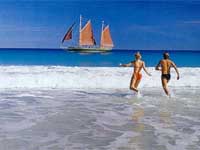
Cable Beach, Broome © WA Tourism
The true richness of Western Australia lies in its huge mineral deposits – gold, diamonds, iron ore, bauxite, nickel, natural gas and oil lie under the ground and provide employment for much of the population. The goldfields of Kalgoorlie still produce a couple of thousand of ounces of gold a day. The young and vital state capital, Perth, was built on the mineral wealth of the state and offers a leisurely lifestyle centred on its lovely beaches for its large immigrant population.
Western Australia is big on extremes; it boasts 8,000 species of wildflower, more than any other region in the world. It has the smallest church, the largest casino and the narrowest pub in the Southern Hemisphere. Its rocky coastline has also been responsible for plenty of tragedy - more than 700 vessels have come to grief here since the first Dutch sailors arrived on the shores of the state in the 17th century.
Perth Travel Guide
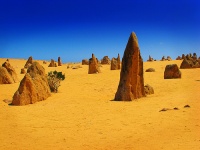 Why? Sunbathe, indulge in some wine tasting, shop for pearls, wander the waterfront of Fremantle, or visit the fun-fair. These are just some of the many diversions that draw people to enjoy a holiday in Perth, Australia's laid-back, remote western city, which is surrounded by some stunning scenery.
Why? Sunbathe, indulge in some wine tasting, shop for pearls, wander the waterfront of Fremantle, or visit the fun-fair. These are just some of the many diversions that draw people to enjoy a holiday in Perth, Australia's laid-back, remote western city, which is surrounded by some stunning scenery.When? Unless you really like it hot, the best times to travel to Perth are during spring (September to November) and autumn (March to May). Summers are extremely hot and dry, and winters wet and mild. Each season in Western Australia, though, offers something special that draws visitors to holiday in Perth, like the explosion of wild flowers in spring, and the whale-watching opportunities during autumn. Even winter is delightful when the countryside turns lush and green.
Who for? Anyone and everyone will find plenty to do and see on a holiday in Perth. The city is packed with attractions to suit everyone, especially food-lovers, who will find more restaurants here per capita than in any other Australian city.
More Info: If you are planning a holiday in Perth make use of our Perth travel guide to find out all you need to know to make the best use of your time in this scenic city. The Perth travel guide features full details of attractions, excursions and events and is updated regularly.
Most of the two million people who live in Western Australia reside in the sophisticated and scenic state capital. Perth grew on the banks of the Swan River, named after the Scottish city of the same name, and was proclaimed by Queen Victoria as a city in 1856. The discovery of gold in Kalgoorlie and Coolgardie, to the east of the city, in the 1890s led to a dramatic rise in its population and an economic boom. Another boom followed in the 1960s with the mining profits of iron ore and nickel.
Today the city is characterised by numerous waterways, green parks and a compact central business district. There is plenty to occupy visitors in Perth, from touring the city by tram or bus, enjoying watersports on the Swan River or just sipping a glass of the famous local wine in a riverside or beachside restaurant. Perth has more restaurants per capita than any other Australian city. Not far from the city is Western Australia’s oldest wine-growing region, Swan Valley, which welcomes tourists to visit the many award-winning family-owned wineries, which offer alfresco and restaurant meals and cellar tastings.
Perth is also the site of the world’s oldest operating mint, and boasts several museums and art galleries, historic buildings, a casino and a good variety of shopping opportunities. Last, but not least, the city offers more than 50 miles (80km) of white sandy beaches in close proximity. Among the most popular are Cottesloe and Scarborough.
....................................................................................................................................................................
New Zealand Travel Guide
Overview
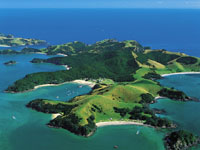
Urupukapuka Island, Bay of Islands, North Island © New Zealand Tourist Board
The two islands have surprisingly different characters. The North Island has dramatic volcanic landscapes and highly active thermal areas, long stretches of beautiful beaches and excellent sailing, ancient indigenous forests and a strong Maori cultural influence. The South Island has a slower pace of life dominated by a magnificent spine of mountains, the snow-covered Southern Alps, and the spectacular scenery of the southern waterways of the fjord lands, with glaciers, deep lakes and verdant forests.
The signing of the Treaty of Waitangi in 1840 was New Zealand's founding document, an attempt to settle disputes between the European settlers and the Maoris, conceding the country to British rule while guaranteeing the Maori people possession of their land and cultural identity. Today, integration has been replaced by a policy of upholding two different cultures alongside each other. Their shared love of sport, most notably the revered national sport of rugby union, and their enthusiasm for adventure and the outdoors is the unifying factor among the whole population.
New Zealand offers a huge variety of action-packed and laid back activities, from bungee jumping to skiing, swimming with dolphins, scenic flights and boat cruises on the fjords, as well as several world famous walking trails with unrivalled scenery. Alternatively visitors can immerse themselves in culture at the museums and galleries of the country's main cities - Auckland and the capital Wellington in the North, and Christ Church in the south.
New Zealand is an easy and compact place in which to travel and its spectacularly dramatic landscape alone, famous for its setting for the 'The Lord of the Rings' film trilogy, makes the long trip to these southern islands more than worthwhile.
.....................................................................................................................................................................
Papua New Guinea Travel Guide
Overview
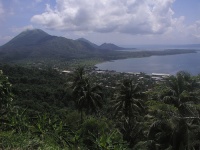
Papua New Guinea landscape © Nickaroundtheworld
Hundreds of different cultures are evident in a relatively small amount of land. Communities have replicated the effect of isolated evolution and cultures have grown into wild forms. As evidence of the drastic isolation, some mountain communities have only just discovered neighbouring tribes, despite living in close proximity for thousands of years. Some communities may still have had no contact with the outside world. Even Port Moresby, PNG's capital and largest city, has no roads connecting it to other major towns. Such drastic separation has fostered more than 800 languages and a multitude of diverse customs and cultures. Yet the nation is unusually unified in religion as Christian missionaries have converted 96 percent of the country.
With almost no connecting paved roads, air travel is mandatory for getting around the country, even though there are only four paved runways. Airplanes flying over the jungle were worshiped in 'cargo cults' for years, especially in WWII. Locals would watch mesmerised at new airport runways as their spirits descended from the heavens. Airline safety has apparently not improved since and travellers wanting to avoid prematurely turning into spirits themselves should review recent airline safety information.
Intrepid travellers take to the jungle and mountains on foot. The most famous route in the country is the Kokoda Track, a 60 mile (96km) hike popular with Australian tourists. The region it covers saw intense fighting between Japanese and Australian forces in WWII. Highland trekking is also a tempting but dangerous. The mountain isolation is extreme and fighting between tribes can endanger tourists. Yet for the undeterred July through August is the best weather to go. Surfers can best hit the waves from November to April in the north and June to September in the south.
PNG's diversity means two trips can never be the same so travelers are welcome to explore their own piece of this wild land.
-----------------------------------------------------------------------------------------------------------

